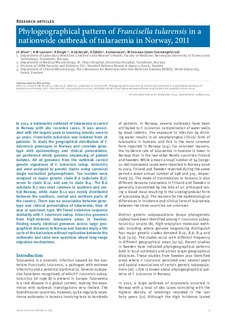Phylogeographical pattern of Francisella tularensis in a nationwide outbreak of tularaemia in Norway, 2011
Afset, Jan Egil; Larssen, Kjersti Wik; Bergh, Kåre; Lärkeryd, A; Sjodin, A; Johansson, A; Forsman, M
Journal article, Peer reviewed
Published version

View/
Date
2015Metadata
Show full item recordCollections
Abstract
In 2011, a nationwide outbreak of tularaemia occurred in Norway with 180 recorded cases. It was associated with the largest peak in lemming density seen in 40 years. Francisella tularensis was isolated from 18 patients. To study the geographical distribution of F. tularensis genotypes in Norway and correlate genotype with epidemiology and clinical presentation, we performed whole genome sequencing of patient isolates. All 18 genomes from the outbreak carried genetic signatures of F. tularensis subsp. holarctica and were assigned to genetic clades using canonical single nucleotide polymorphisms. Ten isolates were assigned to major genetic clade B.6 (subclade B.7), seven to clade B.12, and one to clade B.4. The B.6 subclade B.7 was most common in southern and central Norway, while clade B.12 was evenly distributed between the southern, central and northern parts of the country. There was no association between genotype and clinical presentation of tularaemia, time of year or specimen type. We found extensive sequence similarity with F. tularensis subsp. holarctica genomes from high-endemic tularaemia areas in Sweden. Finding nearly identical genomes across large geographical distances in Norway and Sweden imply a life cycle of the bacterium without replication between the outbreaks and raise new questions about long-range migration mechanisms.